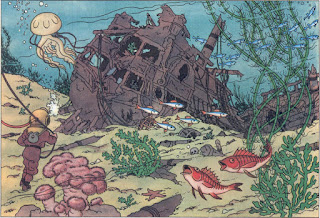leading from
(still collating)
a) Starting at the Painter's Eye
Dali started off with the "Painters Eye" using the idea of the Henu Barque and other works connected to it, Joan Miro's "Figures in the Night Guided by the Phosphorescent Tracks" seemed to be a popular one to use.
See: 1942 a) See: Salvador Dali's "Painter's Eye"
 |
| Salvador Dali's "Painter's Eye" (1942) |
b) Creation of The Unicorn Shipwreck
Hergé referenced this Dali illustration in his Unicorn Shipwreck (1944) along with possibly a Henu Barque depiction from the temple of Ramasses II, and this became another popular work for others to reference at the time.
See: Hergé's Unicorn shipwreck from "The Adventures of Tintin and Red Rackham's Treasure.
c) Creation of "Rhinocerontic Figure of Illisus of Phidias"
Dali based integrated "Rhinocerontic Figure of Illisus of Phidias" (1954) into this into another Henu Barque trail composition, as if he took the idea of the Unicorn with its horn and replaced it with the idea of the rhinoceros horn. This painting also absorbed elements from the cover of the Mickey Mouse comic book story "Mickey Mouse on the cave-man island" as well
d) Creation of the car rally scene
Hergé references Dali's "Rhinocerontic Figure of Illisus of Phidias" in his car rally gathering illustration in Tintin and The Red Sea Sharks (January 1958 ), which I think is also based on the Henu Barque.
e) Creation of "Dionysus Spitting the Complete Image of Cadaqués on the Tip of the Tongue of a Three Storied Gaudinian Woman"
Dali soon with elements from AM Cassandre's "Diversification" poster, integrated parts of the car rally scene into "Dionysus Spitting the Complete Image of Cadaqués on the Tip of the Tongue of a Three Storied Gaudinian Woman"(1958). He transformed Thomson and Thompson into two bunches of grapes while the car door is transformed into an apple. The yellow Volkswagen beetle is transformed into a woman's upper torso with breasts
f) Known meeting
Somewhere between 1959-1960, it is known that they met at a cocktail party through the director and owner of the famous Brussels advertising agency VANYPECO. (https://tintinomania.com/herge-telegramme-dali) and as admirers of one anothers work, they became friends. This speaks nothing of these long distance interactions that appeared to come up between them in their art.
 |
| Dali and Hergé in Brussells in 1962 Souce: https://tintinomania.com |
f) Carnival float from "The Adventures of Tintin and the Picaros"
About fifteen years later, Hergé did an illustration in "The Adventures of Tintin and the Picaros" (September 1975 to April 1976) that in one scene reinterpreted elements of Dali's "Dionysus Spitting the Complete Image of Cadaqués on the Tip of the Tongue of a Three Storied Gaudinian Woman" painting as a carnival float, but the Henu Barque element didn't seem to be visible in this. Perhaps the streamer trailing from the crown references the tentacle like eyelashes from Dali's "The Painter's Eye" and so the flat topped building references the red box in the background of Dali's piece, well it's almost curious to see flat topped structures in both so that is my thinking. The oranges become the upper mouth of the bear.






No comments:
Post a Comment